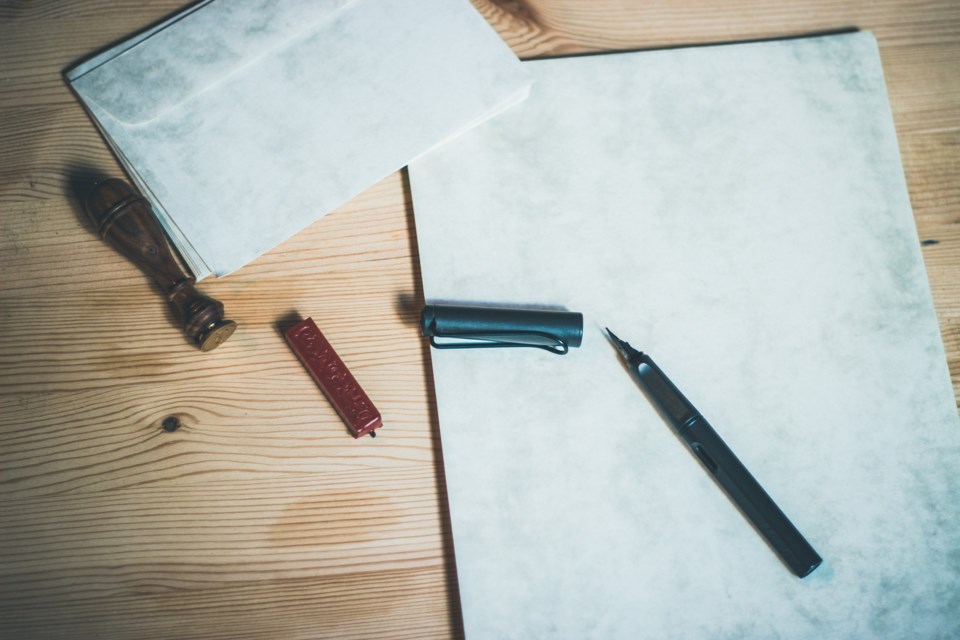Many people reading this will never have felt the joy that receiving a handwritten letter brings.
The demise of the personal handwritten letter has almost declined into oblivion. The improvement in speed, ease of internet connections, low cost of phone calls offers quicker sources of global communication. Smart phones, e- mails, texts, messages, naturally have replaced the former handwritten letter.
Few children today have ever received a letter in the mail, even if they do it is often ignored, of no interest as they prefer messages on their phones.
Very different from my childhood when I was expected to send letters and thank you notes for all kindnesses expressed or gifts received. It was obligatory.
For more than 50 years of my life the handwritten letter was a significant source of communication. My passion for a mailed letter was sparked by my grandmother. At the age of 11 when away from home attending boarding school, every week without fail for six years, she wrote to me. The delight of seeing a personally-addressed envelope in familiar handwriting and notepaper so recently touched direct from her hand to mine was like a hug sent from writer to reader, a very personal connection.
The weekly missives from my grandmother bore news of her small village life; of hymns sung in church, of sandwiches made for funerals, roles she played at her community drama club, of flowers and vegetables flourishing in her garden. She told stories of the doctor and family, of the gardener and other household members working in the large stately home where she was head housekeeper.
No matter where in the world I travelled her letters arrived until in her mid-90s she lost her sight. I still have many of these precious family letters from her, others from my parents, from cousins and friends around the world. They were filled with more detailed information than any email or text today. Though more efficient and much faster emails, messages and text format will never have the longevity and sense of history of the handwritten letter.
Letters were part of the fabric of life.
Phidon Pens, an innovative one-of-a-kind store-on Dickson Street, has over the years done much to revive the tradition. Mano and Baldeep Duggal's small downtown store boasts a large selection of writing instruments, from a practically priced $5 pen to an extravagant $3,500 gold pen. They also offer a wonderful selection of note papers, of journals, and coloured inks.
Over the years they have introduced calligraphy workshops, journalling ideas and other handwritten related courses. They respect and understand the history of the handwritten letter, which throughout history were important and valued documents. Many today are currently on display in worldwide museums. Letters home from war correspondents, from members of royal families. Letters from pioneers and pilgrims arriving in new lands.
Today’s missives will never become chronicles of history connecting future generations with those of the past. Phidon Pens have just introduced a contest for handwritten letters by children.
The fountain pen is now more popular than ever, and it seems to be gaining new appreciation among younger generations.
"I see a resurgence of an age group of about 19 to 35, young students, young professionals coming into the store in awe of what we have here," said Mano. “Our customers, from students to labourers to doctors to judges, come from all walks of life, but they all have something in common."
In an age of email and instant communication, her customers want something slower, more personal much like the ink that flows through its nib, the fountain pen delivers.
"There's a great pleasure they are not deriving out of just a computer," Duggal said.
The fountain pen was invented by a Romanian, Petrache Poenaru, while a student in Paris. He invented the world's first fountain pen, for which the French government issued a patent on May 25, 1827. The first practical fountain pen was invented in 1884 by Lewis Waterman. Although pens with self-contained ink reservoirs had existed for more than 100 years before his invention, they suffered from ink leaks and other problems. Mass production followed and they reigned supreme until the mass production of the ball point pen in the early sixties.
The post office is no longer flooded with personal cards and letters, other forms of communication having replaced the missives. Several times a year I send handwritten letters to close family and friends, written with purple ink in my Lamy fountain pen purchased from Phidon Pens over a decade ago.
I love using that pen and although the handwriting has deteriorated as age creeps in, it brings me great pleasure and satisfaction to mail it, as I hope it does to the recipient. I mourn the loss of the handwritten letter and commend Phidon Pens for their work to revive it.



